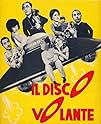Ajouter une intrigue dans votre langueAn exasperated police inspector receives different eyewitness accounts surrounding a downed saucer and its female occupant.An exasperated police inspector receives different eyewitness accounts surrounding a downed saucer and its female occupant.An exasperated police inspector receives different eyewitness accounts surrounding a downed saucer and its female occupant.
- Réalisation
- Scénario
- Casting principal
Lello Bersani
- Reporter
- (non crédité)
Erika Blanc
- Extra
- (non crédité)
Carlo Mazzarella
- Reporter
- (non crédité)
Piero Morgia
- Un Appuntato
- (non crédité)
Graziella Polesinanti
- Contessa Crosara
- (non crédité)
Avis à la une
1964's "The Flying Saucer" is a rarely seen Italian comedy from director Tinto Brass, not to be confused with 1949's "The Flying Saucer," starring its director, Mikel Conrad. Alberto Sordi essays four different roles, mainly as the investigating police sergeant who deadpans throughout the film as each 'eyewitness' confesses to seeing something completely different from everyone else. As the telegrapher, he actually spies the saucer (a dead ringer for the Jupiter 2 from LOST IN SPACE), as well as its occupant, a comely Martian female who does little but wander around, mistaken for a Mardi Gras costumer (shades of "Abbott and Costello Go to Mars"). Sordi's priest spends more time in the local saloon than he does in church, and all four wind up in the asylum by film's end, treated by electroshock therapy because no one will believe them. Fans of Pittsburgh's Chiller Theater rang in the new year, Jan 1 1972, with 1963's "Unearthly Stranger," followed by "The Flying Saucer," thematically linked by their attractive female invaders.
Fairly typical Italian "light" fare from the 1960's, this tale mixes comedy and light sexual farce with some success. The serious and somewhat slow Police Inspector and his bumbling assistant investigate reports of "strange goings-on" in a rural community. A flying saucer with more bells & whistles than Rube Goldberg ever dreamed of dispenses comely female aliens, dressed (barely) in silver "bathing suits" with strategically-placed bubbles who wander about -- mixing in with a "Mardi Gras", and are chased by giddy males to no avail. The highlight of this film is the music, which is haunting. The true shame is that this film is not available on VHS or DVD, and that the soundtrack is not to be found. This film used to be a staple of "late night" "fill-the-time" movie features at local television affiliates.
Despite thinking it is unnecessary, the police chief dutifully complies when he is ordered by a higher-up to interview everyone who has claimed to have seen the flying saucer. What follows provides insight into human motivation and human nature, and is also hysterically funny.
The story uses the plot device of a supposedly non-existent object, the flying saucer, like a psycho therapist uses a rorschach inkblot. But of course, while rorschach inkblots are real printed copies of real inkblots, there is no such thing as a flying saucer. Of course. Or is there? Well, what is it then that is stimulating people's imaginations, revealing what is on their mind, revealing what they care about, showing us "who they are," and where they are situated in a small town's class hierarchy in 1964 Italy? Such things are revealed by what it is that they tell us they have seen, and by the way that they tell us that. Seem to me that what they have seen is not as important to the story as what they say about what they've seen. I think that what matters is what we learn about the *witnesses* to the flying saucer, if it exists, is what we learn about the people, from their testimony.
One reviewer called this movie "light fare." It is not what I would call light fare. Perhaps I might call it deeply penetrating satire. At any rate, I found every minute of this movie to be a delight. One of my favorite movies of all times.
Now, is there actually a flying saucer, or not? Watch the movie and find out.
The story uses the plot device of a supposedly non-existent object, the flying saucer, like a psycho therapist uses a rorschach inkblot. But of course, while rorschach inkblots are real printed copies of real inkblots, there is no such thing as a flying saucer. Of course. Or is there? Well, what is it then that is stimulating people's imaginations, revealing what is on their mind, revealing what they care about, showing us "who they are," and where they are situated in a small town's class hierarchy in 1964 Italy? Such things are revealed by what it is that they tell us they have seen, and by the way that they tell us that. Seem to me that what they have seen is not as important to the story as what they say about what they've seen. I think that what matters is what we learn about the *witnesses* to the flying saucer, if it exists, is what we learn about the people, from their testimony.
One reviewer called this movie "light fare." It is not what I would call light fare. Perhaps I might call it deeply penetrating satire. At any rate, I found every minute of this movie to be a delight. One of my favorite movies of all times.
Now, is there actually a flying saucer, or not? Watch the movie and find out.
Le saviez-vous
- AnecdotesErika Blanc's debut.
- Bandes originalesBALLANDO CON TE
Written by Gorni Kramer (as Kramer) and Vito Pallavicini (as Pallavicini)
Performed by Paolo Occhipinti (as John Foster)
Ed. Style
Meilleurs choix
Connectez-vous pour évaluer et suivre la liste de favoris afin de recevoir des recommandations personnalisées
Détails
- Durée1 heure 34 minutes
- Couleur
Contribuer à cette page
Suggérer une modification ou ajouter du contenu manquant

Lacune principale
By what name was Il disco volante (1964) officially released in Canada in English?
Répondre


























